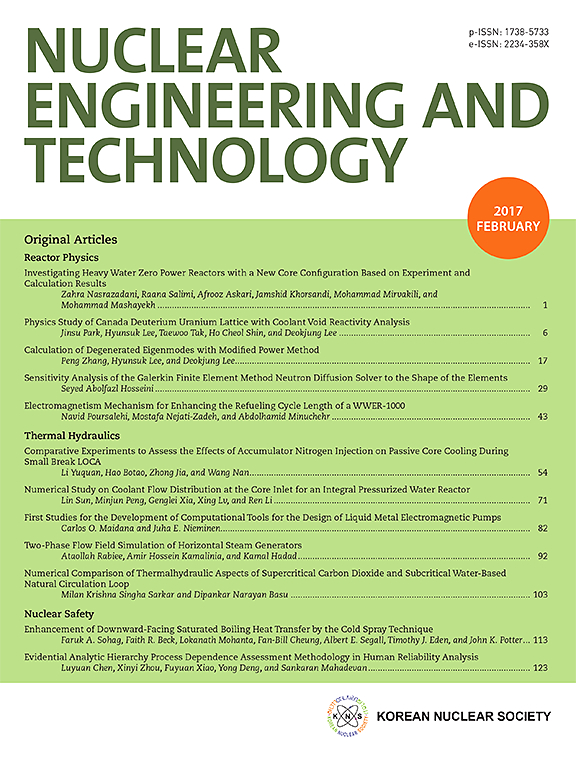利用氧化锆和硼的协同作用:一种优越的辐射屏蔽材料的新途径
IF 2.6
3区 工程技术
Q1 NUCLEAR SCIENCE & TECHNOLOGY
引用次数: 0
摘要
这项开创性的工作提出了一种制造掺杂b的ZrO2的新方法,在ZrO2基体中生成原位ZrB2O5。一种经济有效的利用锆石矿物的水热合成方法产生了一种具有特殊辐射屏蔽性能的材料。将B并入ZrO2晶格结合了ZrO2的伽马衰减和B对电离辐射的中子屏蔽。XRD, SEM和EDX表征揭示了其结构性质,相组成和元素分布。蒙特卡罗模拟和XCOM理论建模研究了B原子在0.0332-2.506 MeV γ射线能量范围内屏蔽参数的作用。结果表明,B浓度的增加略微降低了屏蔽性能,但提高了屏蔽材料的力学性能,包括晶体尺寸、晶格畸变和位错密度。B浓度从2.1 wt%增加到5.4 wt%, LAC值降低到65.959 ~ 58.613 cm-1 (0.0332 MeV)、0.464 ~ 0.461 cm-1 (0.511 MeV)和0.208 ~ 0.270 cm-1 (2.506 MeV)。高达5.4 wt%的B浓度增强了机械性能,而不会显著影响辐射屏蔽,特别是在中等能量下。本文章由计算机程序翻译,如有差异,请以英文原文为准。
Harnessing zirconia and boron synergy: A novel pathway to superior radiation shielding materials
This pioneering work presents a novel approach for manufacturing B-doped ZrO2, creating in-situ ZrB2O5 within the ZrO2 matrix. A cost-effective hydrothermal synthesis using zircon mineral yields a material with exceptional radiation shielding properties. Incorporating B into the ZrO2 lattice combines ZrO2's gamma attenuation with B's neutron shielding against ionizing radiation. XRD, SEM, and EDX characterization revealed structural properties, phase compositions, and elemental distributions. Monte Carlo simulation and XCOM theoretical modeling investigated B atoms' role in shielding parameters across 0.0332–2.506 MeV γ-ray energies. Results show increased B concentration slightly decreases shielding properties while enhancing mechanical properties including crystallite size, lattice distortions, and dislocation density. B concentration increases from 2.1 to 5.4 wt% decrease LAC values to 65.959–58.613 cm-1 (0.0332 MeV), 0.464–0.461 cm-1 (0.511 MeV), and 0.208–0.270 cm-1 (2.506 MeV). B concentration up to 5.4 wt% enhances mechanical properties without significantly affecting radiation shielding, especially at intermediate energies.
求助全文
通过发布文献求助,成功后即可免费获取论文全文。
去求助
来源期刊

Nuclear Engineering and Technology
工程技术-核科学技术
CiteScore
4.80
自引率
7.40%
发文量
431
审稿时长
3.5 months
期刊介绍:
Nuclear Engineering and Technology (NET), an international journal of the Korean Nuclear Society (KNS), publishes peer-reviewed papers on original research, ideas and developments in all areas of the field of nuclear science and technology. NET bimonthly publishes original articles, reviews, and technical notes. The journal is listed in the Science Citation Index Expanded (SCIE) of Thomson Reuters.
NET covers all fields for peaceful utilization of nuclear energy and radiation as follows:
1) Reactor Physics
2) Thermal Hydraulics
3) Nuclear Safety
4) Nuclear I&C
5) Nuclear Physics, Fusion, and Laser Technology
6) Nuclear Fuel Cycle and Radioactive Waste Management
7) Nuclear Fuel and Reactor Materials
8) Radiation Application
9) Radiation Protection
10) Nuclear Structural Analysis and Plant Management & Maintenance
11) Nuclear Policy, Economics, and Human Resource Development
 求助内容:
求助内容: 应助结果提醒方式:
应助结果提醒方式:


